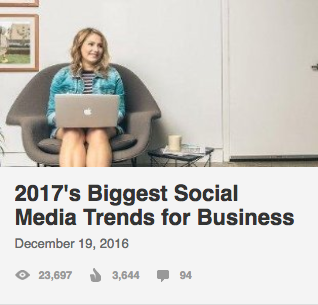Let’s be clear right upfront: this post is not about clickbait—that dubious practice of pulling in clicks by withholding information (“you’ll never believe what happened next!”) or misleading readers (“lose 30 pounds by eating this one weird food!”).
Instead, it’s about crafting quality social media content that provides clear value and compels readers to click through to your website or blog to further engage with you and your brand. Here are seven key ways to make your content more clickable.
1. Provide clear value to the right readers
Your audience is made up of real people who have real needs and goals, and who are—let’s face it—probably pressed for time. Before you can speak meaningfully to them, you need to understand who they are so you can tailor your content to help them solve their problems or even just improve their day.
Why should they click through to read more? You can’t tell them if you haven’t done the research to answer that question clearly and honestly.
Make sure your social media post answers the question “What’s in it for me?” from the reader’s perspective. What benefits will readers get from reading your content? What problems can they avoid? Provide a tangible benefit tailored to your most valuable potential readers.
One simple way to connect with readers is to write in the second person using words like “you” and “your.” It’s a simple technique that immediately makes your writing more accessible.
Think about it: are you interested in how businesses can improve their conversion rates, or how you can improve your conversion rate? Making it personal gets potential readers invested in your message right from the start. Always ask yourself if your post feels personally compelling enough that it would get you to click—even if you didn’t already know how awesome the linked content is
3. Build curiosity
Curiosity may have killed the cat, but it can breathe real life into a social media post.
Asking a question is one easy way to arouse readers’ curiosity and get them thinking about how much they have to learn about a topic. But be careful with this technique, since a question in a headline may get your post flagged as clickbait if you don’t provide any context about what a reader will actually find when they click through to your site.
Citing a surprising fact, statistic, or quote is another great way to build curiosity, since people have been shown to become curious when they discover something that goes against their expectations.
4. Use simple language and active voice
Some of the original research on how people read online shows that they actually don’t read at all—they scan.
People approach their social network feeds the same way, scanning rather than reading word-for-word, just waiting for something to catch their eye—or stop their thumb, in the mobile world. Using clear, simple language is the best way to catch followers’ attention long enough to encourage them to click through to read more.
Never use a three-syllable word (like “utilize”) when a one-syllable word (“use”) will do. Always use active (rather than passive) sentences to keep your sentence structure simple and easy to understand. If you need help tightening up your writing for social media, check out our post on writing resources for non-writers.
5. Include a call to action
It’s an easy thing to overlook, but if you want potential readers to click through to your content, it’s a good idea to actually ask them to click through to your content. That ask is a call to action.
6. Make your content easily shareable
Research shows that the majority of clicks on articles come from posts shared by friends and contacts, rather than from publishers. That means your most clickable social media posts may be written by people you have never met—your readers and fans.
Use social sharing buttons to make it easy for others to share content from your website on their own social media channels to bump up your referral traffic.
7. Optimize for each social network
While the strategies above are universal, there are a few specifics to keep in mind for individual networks.
Did you know that when posting links to Facebook, you can edit the headline and excerpt pulled in from the meta-data? Just click on the text to change it. Check to ensure both components follow the principles in this post and don’t get cut off.
Keep in mind that overly promotional posts don’t fare well on Facebook, so avoid phrases like “buy now” and “shop now.”
And just in case you’re tempted, be aware that using shady clickbait techniques is particularly damaging on Facebook, since the algorithm bumps clickbait to the bottom of the news feed. Focus on honest engagement using the strategies in this post instead.
Internal LinkedIn data shows that posts linking to “best-of” lists get 40 percent more amplification, putting your content in front of more eyeballs and increasing your potential number of clicks.
What kinds of numbered lists could you create to share on LinkedIn?
 Image via Ryan Holmes on LinkedIn.
Image via Ryan Holmes on LinkedIn.Images and links no longer count toward your Tweet’s 140 precious characters. Since Tweets with images or videos get three times more engagement than text-only Tweets, you should now include a compelling GIF, image, or video with every Tweet to maximize engagement and clicks.

Follow
 Vevo
Vevo ✔@Vevo
The Starboy is a true rockstar. Watch "False Alarm" from #VevoPresents @theweeknd now: http://vevo.ly/lYMzaK
12:17 AM - 22 Dec 2016
4141 Retweets
133133 likes
The only place you can include a link on organic Instagram content is in your bio. That means while it’s a great network for engagement, it’s a challenging one for clickable content—but it’s not impossible, as long as you regularly update the link in your bio to point to your current content or campaign.
Vertical images take up much more space in Pinterest results and make it easier to draw Pinners’ attention, especially on mobile, so use portrait-oriented Pins to maximize clicks.

Image via Pinterest.
Now that you know how to speak directly to your audience and optimize your content for each network, you’re well equipped to show potential readers exactly how your content can provide them with unique and compelling value. Because, after all, there’s nothing more clickable than that.
No comments:
Post a Comment